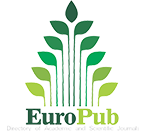The significance of typography in the linguistic landscape during the Fascist period in Italy (1922–1943)
Vol 5, Issue 3, 2023, Article identifier:1885
VIEWS - 455 (Abstract) 123 (PDF)
Abstract
This paper discusses the use of lettering and typeface in the linguistic landscape in Italy during the Fascist period (1922–1943), focusing on inscriptions on public buildings and the lettering used in propaganda posters and other materials. After a general introduction, some definitions, and an overview of Italian Fascism, the paper introduces the methodology employed, which consists first of an analysis of the lettering used in Fascist public writings and their link to ancient Rome on the one hand and modernity on the other, and second of a simple test carried out among a sample of students at Universiti Malaya (Malaysia) to investigate their perception of ‘Fascist’ fonts. There follows an analysis and discussion of the data, which leads to the conclusion that some of the ideas behind this right-wing movement seem to be portrayed by the specific lettering and fonts used. Finally, these conclusions are compared to those arrived at in previous research on fonts
Keywords
Full Text:
PDFReferences
Amare N, Manning A (2012). Seeing typeface personality: Emotional responses to form as tone. In: Proceedings of 2012 IEEE International Professional Communication Conference; 8–10 October 2012; Orlando, FL, USA. pp. 1–9.
Bignami S, Rusconi P (2012). The Arts and Fascism: Italy in the Thirties (Italian). Giunti Editore.
Britannica (2023). Art Deco. Available online: https://www.britannica.com/art/Art-Deco (accessed on 17 October 2023).
Brumberger ER (2003). The rhetoric of typography: The persona of typeface and text. Technical Communication 50(2): 206–223.
Coluzzi P (2021). The significance of typography in the linguistic landscape: Hippie vs. punk. Journal of Modern Languages 31(1): 86–111. doi: 10.22452/jml.vol31no1.5
Cresti C (2015). Architects and Architecture of the “Fascist Era” (Italian). Pontecorboli Editore.
Dafont (2023). Available online: https://www.dafont.com/mouse-deco.font? (accessed on 17 October 2023).
Eco U (2020). How to Spot a Fascist. Harvill Secker.
Fonts4free (2023). Available online: https://www.fonts4free.net/empiric-roman-font.html (accessed on 17 October 2023).
Garfield S (2012). Just My Type: A Book about Fonts. Avery.
Germinario F (2018). CasaPound: The Proletarian Right and the “Community of Struggle” (Italian). Asterios.
Griffin R (1998). The sacred synthesis: The ideological cohesion of Fascist cultural policy. Modern Italy 3(1): 5–25. doi: 10.1080/13532949808454789
Hyndman S (2016). Why Fonts Matter. Virgin Books.
Järlehed J, Jaworski A (2015). Typographic landscaping: Creativity, ideology, movement. Social Semiotic 25(2): 117–125. doi: 10.1080/10350330.2015.1010318
Jaworski A (2015). Globalese: A new visual-linguistic register. Social Semiotic 25(2): 217–235. doi: 10.1080/10350330.2015.1010317
Juni S, Gross JS (2008). Emotional and persuasive perception of fonts. Perceptual and Motor Skills 106(1): 35–42. doi: 10.2466/pms.106.1.35-42
Koch BE (2011). Human Emotion Response to Typographic Design [PhD thesis]. University of Minnesota.
Morrison GR (1986). Communicability of the emotional connotation of type. Educational Communication and Technology 34(4): 235–244. doi: 10.1007/BF02767404
Nicoloso P (2011). Mussolini Architect: Propaganda and Urban Landscape in Fascist Italy (Italian). Einaudi.
Passmore K (2014). Fascism: A Very Short Introduction, 2nd ed. Oxford University Press.
Schmid U (2005). Style versus ideology: Towards a conceptualization of Fascist aesthetics. Totalitarian Movements and Political Religions 6(1): 127–140. doi: 10.1080/14690760500110247
Stöckl H (2005). Typography: Body and dress of a text—A signing mode between language and image. Visual Communication 4(2): 204–214. doi: 10.1177/1470357205053403
Sutherland P (2015). Writing system mimicry in the linguistic landscape. SOAS Working Papers in Linguistics 17: 147–167.
Tarquini A (2016). History of Fascist Culture (Italian), 2nd ed. The Mill.
van Leeuwen T (2005). Typographic meaning. Visual Communication 4(2): 137–143. doi: 10.1177/1470357205053749
van Leeuwen T (2006). Towards a semiotics of typography. Information Design Journal 14(2): 139–155. doi: 10.1075/idj.14.2.06lee
DOI: https://doi.org/10.59400/fls.v5i3.1885
(455 Abstract Views, 123 PDF Downloads)
Refbacks
- There are currently no refbacks.
Copyright (c) 2023 Paolo Coluzzi

This work is licensed under a Creative Commons Attribution 4.0 International License.











_%E5%89%AF%E6%9C%AC1.png)